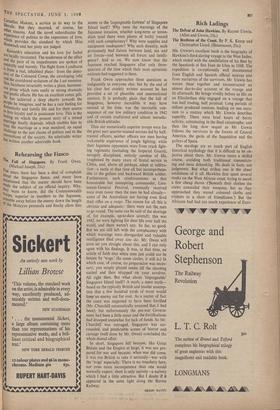Rich Ladings
The Defeat of John Hawkins. By Rayner Unwin. (Allen and Unwin, 25s.) The Brethren of the Coast. By P. K. Kemp and Christopher Lloyd. (Heinemann, 21s.) MR. UNWIN'S excellent book is the biography of Hawkins's third slaving voyage to the West Indies, which ended with the annihilation of his fleet by the Spaniards at San Juan de Ulua in 1568. The expedition is exceptionally well documented from English and Spanish official sources and from narratives of the survivors. Mr. Unwin has woven these together and reconstructed an almost day-to-day account of the voyage and its aftermath. He brings vividly before us life on an Elizabethan ship engaged on a voyage that was half trading, half piratical. Long periods of tedium produced tensions, leading on one occa- sion to a mutiny which Mr. Unwin describes superbly. There were brief hours of hectic activity, culminating in the final catastrophe; and then the long slow sequel as Mr. Unwin follows the survivors. in the forests of Central America, the gaols of the Inquisition and the galleys of Spain.
The sea-dogs are so much part of English historical mythology that it is difficult to be ob- jective about them. Mr. Unwin steers a skilful course, avoiding both traditional romanticis- ing and mere debunking, He deals in facts, not judgments. But what strikes one is the sheer sordidness of it all. Hawkins first spent several weeks on the West African coast, trying to sneak a few cheap slaves. ('Beneath their clothes the crews concealed their weapons, but as they approached they waved coloured cloths and trinkets in a show of friendliness.') But the Africans had had too much experience of Euro- peans to be caught so easily. To get a cargo Hawkins had to ally with a cannibal tribe in a local war. After severe fighting, those of the vanquished who were not killed or eaten on the spot, or reserved for later feasts, left him with 'the richest lading that he had ever taken to the Indies.' During the ghastly Atlantic crossing many of the slaves died battened below hatches. In America force and bribery had to be used to persuade the Spanish authorities to allow the trade for which the colonists were as eager as Hawkins himself. At Rio de la Hacha an escaped negro slave and a half-caste, on promise of safety and freedom, gave Hawkins military information essential for bringing the Spaniards to terms. When Hawkins had concluded his deal, with profit to both sides, he handed the negro and the half-caste over to the Spaniards. They were quartered and hanged respectively.
And yet, within this squalid framework, what also stands out in Mr. Unwin's story is the astonishing power of endurance and will to live shown by those who survived the destruction of the English fleet. Job Hortop returned to England after twenty-two years of prison and galley slavery, punctuated by repeated escapes. David Ingram and two others made their way, 3,000 miles in eleven months, up the desolate and unmapped coast from Mexico to Nova Scotia. Ingram said they walked. Historians have been as sceptical of this claim as of the elephant Ingram saw en route. But they got there somehow; and Mr. Unwin almost makes me believe in the elephant.
Commander Kemp and Professor Lloyd deal with the successors of Hawkins and Drake, the buccaneers of the seventeenth century. The Elizabethan sea-dogs opened a door into the West Indies. Under Oliver Cromwell an English government first took over from private enter- prise. and Jamaica was annexed as a British base for the slave trade. But between Cromwell and William III English naval power declined, and commercial interests were less decisive in the formation of foreign policy. During these years it was the buccaneers who defended and ex- tended British interests in the Caribbean, with the connivance of home governments. But with the revival of Cromwellian policies in the six- teen-eighties, the buccaneers became a nuisance to regular traders. Driven out of the Caribbean, the Brethren of the Coast had thirty years of pro- fitable activity in the Pacific, until the British navy followed them there too. By the seventeen- twenties their day was over.
The authors describe the main buccaneering voyages in some detail: a surprising number of the Brethren kept journals. Many of the early buccaneers were old Cromwellian soldiers, and they are always theologically interesting. A mutiny aboard the Trinity in 1681 led not only to a tougher way with prisoners but also to better Sabbath observance. A future Archbishop was said to have accompanied one of the voyages— the Rev. Launcelot Blackburn, whose episcopal seraglio Horace Walpole later explained by say- ing 'the jolly old Archbishop of York gained more hearts than souls.'
The authors intersperse their narrative with more general reflections. The literary in- fluence of the buccaneers, they suggest, 'has been even more lasting than the economic or cartographical.' Books by and about them won great popularity — early examples of the eighteenth-century literature of roguery. Alex- ander Selkirk, the original Robinson Crusoe, was a buccaneer; and Defoe may have 'been the author of the best-selling General History of the Robberie.s and Murillers of the Most 'Notorious Pyrates (1724). Gulliver's travels in the southern seas also owed something to the buccaneers who opened them up; and it was Simon Hatley, pettY officer in the Duchess, who in October, 1719, shot the Ancient Mariner's albatross. This is a vigorous, learned, many-sided book. • CHRISTOPHER IIlLI



































 Previous page
Previous page